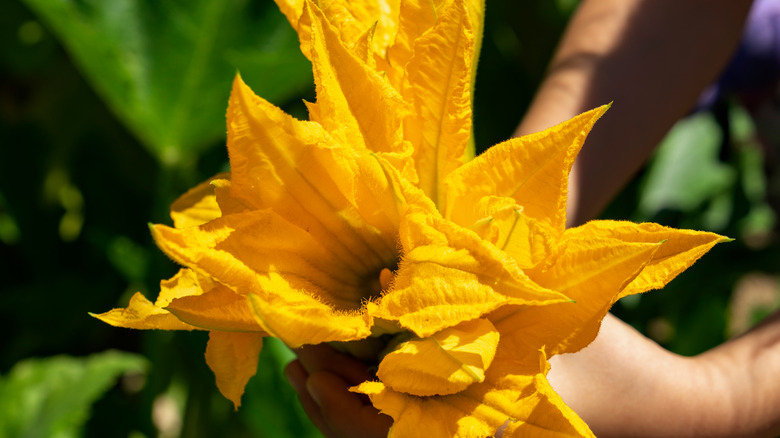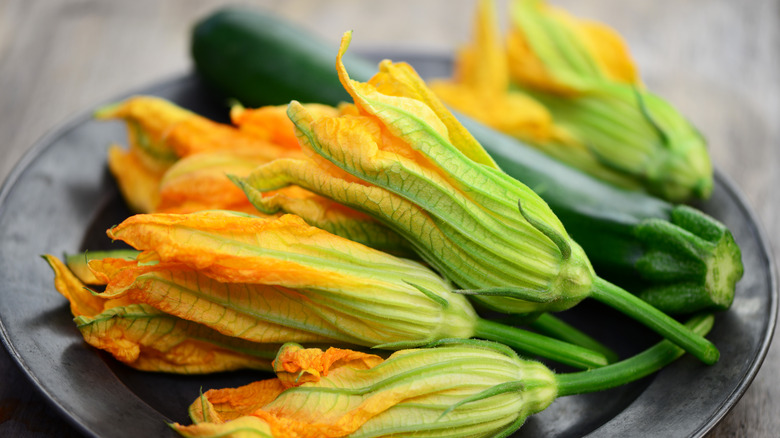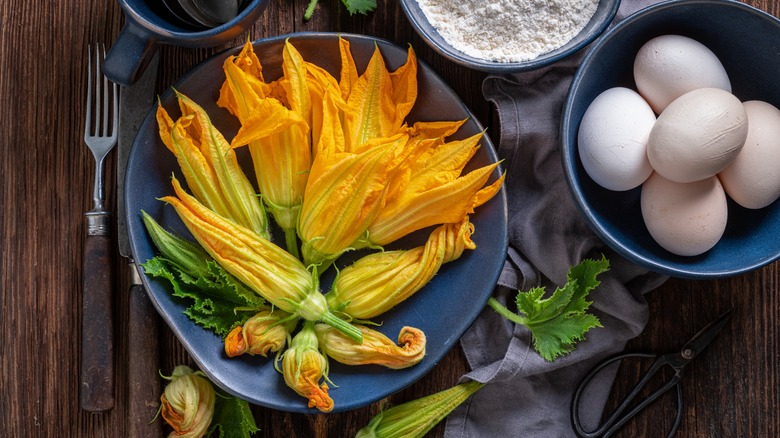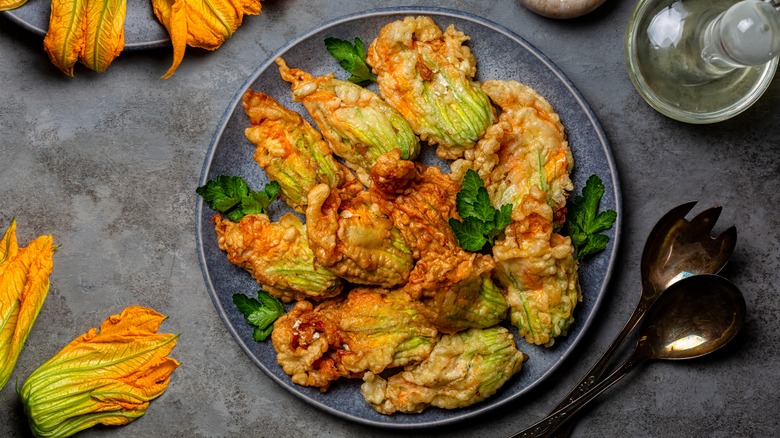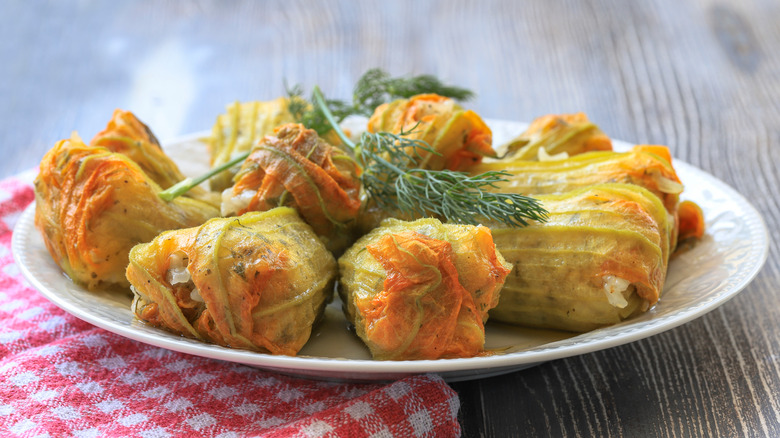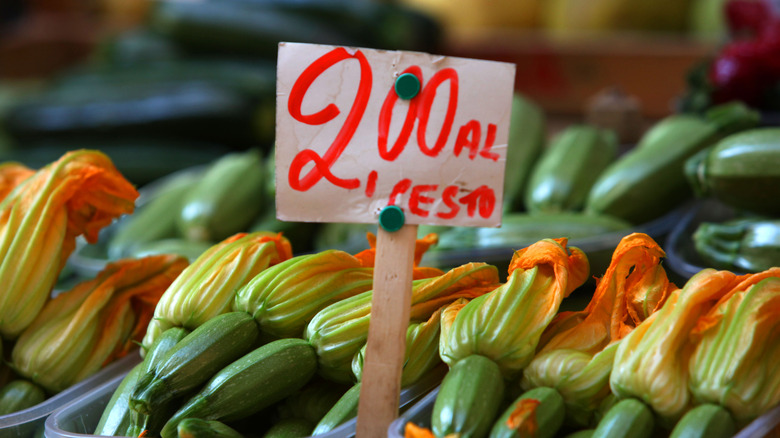Fiori Di Zucca: The Italian Ingredient That Should Be On Your Menu
Fiori di zucca are a gorgeous and tasty edible flower found in Italian cuisine from Venice in the north to the tip of the boot in the south. So honored in modern Roman culture, fiori di zucca ripieni fritters adorn the cover of the best-selling, "Tasting Rome" cookbook. Fiori di zucca, the Italian term for zucchini flowers, are a fragrant delicacy in many gastronomic circles across Europe, Asia, and Scandinavia. Less common in the United States, these delicious flowers are a treat for your senses.
There are 15 different types of zucchini and many more types of squash, with the species dating back 10,000 years, according to All About Gardening. It was the Italians who developed modern zucchini in the 19th century. Called zucca in Italian and courgette in French, zucchini is a popular ingredient in western Mediterranean cuisine. Part of the gourd family, the scientific name for zucchini is Cucurbita pepo, per Britannica.
Gardener's Path reports that most zucchini plants are monoecious: producing both male and female flowers to ensure their survival. Having both flowers aids in effortless pollination. Male flowers are easy to spot because they have thin stems and lack the stigmas of the female flower. Once pollination occurs, the female flowers begin to grow baby zucchini. The male flowers, having served their purpose, make for delicious edible delicacies.
How to grow fiori di zucca
The zucchini plant is a medium-sized bushy, creeping squash plant that has substantial wide leaves, with rough fuzzy stems, and large, spiky, five-petaled saffron orange flowers the size of lily flowers. Zucchini is the fruit of the plant and is typically long and slender with a tough, dark green or bright yellow skin. Some zucchini varieties produce a smaller variegated green fruit, per Britannica. Zucchini plants can produce ample fruit throughout their growing season so harvesting a few delicious blossoms for your next meal won't impact an abundant fruit harvest.
SFGate indicates that, while easy to grow, zucchini plants are a type of summer squash and grow best in warm, sunny climates. The plants thrive in loose, well-drained, slightly acidic soils with ample organic material and nutrients. These days, zucchini can be grown in hothouses for a fresh supply all year round. If you have a garden, plant a row of zucchini plants for the blossoms and the fruit.
What do fiori di zucca taste like?
Fiori di zucca tastes like squash perfume, according to NPR. In fact, KItchn claims the only real flavor you will notice is a squashy one. Some have tried to pin the flavor down with more nuanced terms such as "cool and crisp" (via SeedsNow) while others have likened them to a "sweet radish" (per SiLive). Whereas Organic Authority classes them as "light and airy," Taste of Home tries to pin the flavor of these beautiful flowers as ever-so-slightly sweet with notes of summer squash.
With such subtle flavors, care must be taken with other ingredients to avoid overpowering the blossom. The flowers are often paired with simple foods like ricotta and mozzarella cheese, rice, eggs, pizza, and pasta, per The Spruce Eats. Pungent herbs, garlic, zingy pepper, and spice can ruin the aromas and flavors of fiori di zucca. Equal care must be taken when cooking the flowers because they burn easily.
Cooking with fiori di zucca
Fiori di zucca petals are paper thin and tear easily so handle them gently. Wash the flowers in cool water and pat them dry with a linen or paper towel. Arrange the blossoms on a plate and keep them cool. Fiori di zucca won't last more than a day or two, so be prepared to use them right away.
Perhaps the most popular way to eat fiori di zucca is to make Neapolitan sciurilli or Roman fiori di zucca ripieni fritti. Both preparations are lightly battered and create a quick-fried zucchini flower fritter. According to Italian Elle, the stuffed, battered, and fried zucchini blossoms are prevalent street food treats in Naples and Calabria, each with its own variation on the recipe. Neapolitans add shredded parmesan cheese, yeast, and eggs to their batter while Calabrians omit the eggs and yeast. Blossoms are stuffed with cheese, meat, fish, and vegetables. Taste Atlas reveals that Ligurian fiori di zucca ripieni is stuffed with a blend of cooked, mashed zucchini, potatoes, and parmesan cheese. Some recipes call for sparkling water to create a frothy, light batter. Crunchy fiori di zucca fritti can be stuffed or served plain.
Stuffed fiori di zucca ripieni fritti
The simplest fiori di zucca ripieni fritti recipe hails from Rome. According to "Tasting Rome" flour, icy-cold sparkling water, and a pinch of salt are all that is needed for a flaky and crisp batter. Roman fiori di zucca ripieni fritti are stuffed with thin slices of fresh, soft mozzarella di bufala (buffalo mozzarella) and pungent, salty anchovy filets.
Carefully open the cleaned and dried flowers and layer a thin slice of cheese with a few anchovy filets and top with another thin slice of cheese. Once the ingredients are stuffed inside the flowers, the spiky tips are pinched shut. The little orange packets are dipped in batter and pan-fried just until browned. Arrange the cooked blossoms on a platter lined with paper towels to wick away any extra oil. Serve the warm fiori di zucca ripieni fritti with a cold glass of crisp Italian white wine like a minerally fiano, grassy verdecchio, peachy pecorino, or sharp trebbiano.
Where to find fiori di zucca
If you are lucky, you can find an ample supply of fiori di zucca in season at your local farmer's market or specialty produce stand. The Spruce Eats cautions that the fragile blossoms must be used within a day or two after purchasing them. Wrap the flowers in damp paper towels and store them in plastic bags or on a covered plate in the refrigerator. They go on to suggest the blossoms can be frozen for later use.
If you can't find fiori di zucca in your market, ask your neighbors if they grow the plants or consider growing a plant yourself. If you have a garden, grow a few plants in a spacious row. If not, consider container gardening on a sunny patio. SFGate indicates that the plants aren't difficult to grow. Consult a gardening book or website for information on your growing season and region.
